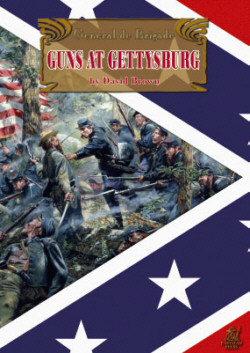|
|
|||||||||||||||
|
|
|||||||||||||||
 |
|||||||||||||||
 |
|
What’s Cooking? Dave Brown, author of the well known Napoleonic rules General de Brigade (GdB) has finally published his adaptation of the system for the American Civil War. Like GdB, Guns At Gettysburg (GaG) is a tactical game. It is not designed for fighting entire battles but for select portions of them. The first included scenario, for example, is the opening attack on the Mumma Farm at Antietam. It is an orders driven game, whereby units must act on orders until given new ones or a local commander changes them on his own initiative. The mechanisms will be familiar to most wargamers and should be easy to pick up quickly.
List Of Ingredients When Guns At Gettysburg arrives in the mail, you get a very nicely produced book. The cover is a glossy full color and all the interior pages are nice coated stock. I have nothing against rules printed on ordinary copy paper, but I admit there’s something very satisfying about a high quality paper (okay, okay, nothing to do with the game at hand but, hey, it’s my web site!). At the center is the player summary card which is laminated for durability. I wish it had not been stapled into the book however. I plan to photocopy it as I hate tearing apart a binding - no matter how carefully - to remove the center pages. There is black and white artwork throughout and a few pages of color pictures. All in all a very nic looking production, up to the usual standard of the publisher Partizan Press. How Big? How Many? How Long? GaG is a decidedly tactical game as reflected in the game scale. The ground scale is set at (very approximately) 1 inch = 25 yards. Figure ratio is 1:20. There is no stated amount of time a turn is supposed to represent. Basing, Braising, and Roasting: How To Basing in 15 mm follows the accepted standards of Fire & Fury and Johnny Reb III. Infantry should be based on an 8-10 mm frontage per figure in two ranks. Functionally this means a base 20 mm wide by however deep is needed. Cavalry get 10 - 15 mm per figure and artillery 30 to 40 mm per gun. No depths are given except to note that as depths will be so far out of ground scale in any case, whatever the miniatures need to fit will work fine. Which Comes First, Cheese or Salad? Guns At Gettysburg generally uses an I-GO-U-GO turn sequence. Some things are simultaneous such as Initiative, Compulsory Moves and Melee. The remaining phases are largely alternating. First one side moves followed by the other. After movement is complete one side fires followed again by the other. One of the critical phases is the Command phase. During the Command phase the C-in-C may attempt to change one brigade order. Additionally, one brigade general per side may attempt to change their orders. Otherwise, all units are expected to follow their current orders. The Gourmet Touch The game mechanisms will be largely familiar to most wargamers. The Good, the Bad, and the Incomprehensible: Like GdB this is a well written, well edited, polished product. I’ll describe each very briefly here. Orders: Each brigade must be operating under one of the following: Assault, Engage, Support, Move, Hold, Retire. Each carries with it requirements for closing with the enemy (or not), objectives to be taken/held etc. Changing a brigade’s orders requires a die roll by either the C-in-C or a brigade commander. This means you only have an opportunity to change two orders per turn - one by the C-in-C and one by a brigade general, and neither is guaranteed! Charging: Charges are almost an entire game in themselves. Fortunately the rules are written in a flow-chart style so each step from declaring the charge, to evading the charge, defensive fire and opportunity charges are clearly laid out. I do wish, however, that a charge summary had been included on the summary card. One of the four pages of the card is simply a black and white reproduction of the cover - that space could have been more profitable used by having an actual Charge “low” diagram. Movement: Movement is quit straightforward and includes the costs for many tactical moves that larger scale rule sets may ignore. These include the cost to recall skirmishers, step back, and change formation. One small wrinkle to watch out for. If a unit goes prone, when ordered to stand up a die roll is required and a Brigadier must be within 12”! There is also a penalty for large regiments (40+ figures) to execute and formation change. Fire Combat: Fire combat is a simple affair. Roll 2D6, add and subtract some modifiers and cross index wit the number of figures firing. The result is the number of casualties inflicted. Artillery fires the same way though with separate DRMs and a separate casualty chart. Melee: Melee is likewise a relatively uncomplicated affair. Each side rolls 2D6 and the high roll wins. The difference between the two rolls dictates the results in terms of retreats, routs and morale checks. The difference also dictates casualties. Winning infantry inflict one casualty for every point of difference, while losing infantry only inflict one casualty for every twelve points of difference. Winners must check to see if they can (or must!) pursue or not. There are rules and modifiers for reinforcing melees, for having numerical superiority etc. In fact there are quite a few modifiers to be checked but as a summary chart is provided this should really be no issue. Morale: Like everything else, morale checks are simple 2D6, add modifiers and consult the Morale Results Table. There are columns for each of 5 reasons for checking morale, so your likely results are different if you are attempting a charge versus being charged. All in all, there is nothing here that is terribly innovative or new. All of the mechanisms are tried and true. However, they are very clearly explained and good, comprehensive example abound. The illustrations are simple block diagrams instead of photos but they clearly communicate the rules. Where to Get Help If the Smoke Alarm Goes Off Home Page: The author maintains an excellent web site for all of his rules located at General de Brigade. The site includes a blog, forum, FAQ and more. Support: The author is a frequent visitor to his forum and frequently posts rules changes/additions and clarifications there. Back to the Blue Rules Revue....
|
 |
|||
|
|
|||
